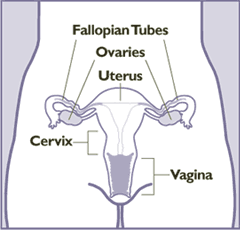Ovary
|
|
Ovaries are a part of a female organism that produces eggs.
Mammalian ovaries
Ovaries are part of the vertebrate female reproductive system. Normally, a female will have two ovaries, each performing two major functions: producing eggs and secreting hormones. Ovaries in females are homologous to testes in males. Most birds have only one functioning ovary; snakes have two, one in front of the other.
As female mammals develop within the womb, each ovary develops a number of immature eggs associated with groups of other cells called follicles. While mammals were thought to develop their entire supply of eggs prenatally and soon after birth, new evidence from laboratory mice has called this into question, showing that female mice in fact produce new eggs throughout their reproductive lifetime. However, there is no direct evidence showing that human females produce new eggs after birth. As the animal (or person) becomes reproductively mature (the process called puberty in humans), eggs will periodically mature and be released from the ovary (a process called ovulation) so that they will be available for fertilization by sperm. A fertilized egg resulting from union with a sperm becomes a zygote and then an embryo as it develops.
Animal and human ovaries also produce various steroid and peptide hormones. Estrogen and progesterone are the most important of these in mammals. These hormones induce and maintain the physical changes of puberty and the secondary sex characteristics. They support maturation of the uterine endometrium in preparation of implantation of a fertilized egg. They provide signals to the hypothalamus and pituitary that help maintain the menstrual cycle. Estrogen plays an important role in maintaining subcutaneous fat, bone strength, and some aspects of brain function.
In humans, an egg launched from an ovary has to traverse a slight space before entering the fallopian tube and moving gradually down to the uterus. If fertilized, it implants itself into the lining of the uterus and develops as the pregnancy continues. If the fertilized egg settles into the fallopian tube instead of the uterus an ectopic pregnancy will result. If the egg fails to release from the follicle in the ovary an ovarian cyst may form. Small ovarian cysts are common in healthy women but large cysts can be an advanced manifestation of polycystic ovary syndrome.
Ovaries of plants
An ovary is the part of the female flower which holds the ovule(s). After pollination, the ovary will grow into the fruit, while the ovule(s) become the seed(s). Some wind pollinated flowers have much reduced and modified ovaries. together with the pistol, made up of the style and stigma, the ovary or ovaries make up the female reproductive structure of a flower known as a gynecium or carpel.
Anatomy Clipart and Pictures
- Clip Art (https://classroomclipart.com)
- Anatomy Illustrations (https://classroomclipart.com/clipart/Illustrations/Anatomy.htm)
- Anatomy Clipart (https://classroomclipart.com/clipart/Anatomy.htm)
- Anatomy Animations (http://classroomclipart.com/cgi-bin/kids/imageFolio.cgi?direct=Animations/Anatomy)
| Reproductive system |
| Female: Cervix - Clitoris - Clitoral hood - Fallopian tubes - Bartholin's glands - G-spot - Hymen - Mammary glands - Ovaries - Skene's glands - Urethra - Uterus - Vagina - Vulva |
| Male: Bulbourethral glands - Cowper's glands - Ejaculatory duct - Epididymis - Foreskin - Frenulum - Penis - Prostate - Scrotum - Seminal vesicles - Spermatic cord - Testes - Urethra - Vas deferens |
| Endocrine system | |
| Adrenal gland - Corpus luteum - Hypothalamus - Ovaries - Pancreas - Parathyroid gland - Pineal gland - Pituitary gland - Testes - Thyroid gland |



